Search
Search Results

Image
Detail from the Sarcophagus of Ankhnesneferibre
Egyptian hieroglyphs carved on the sarcophagus of Ankhnesneferibre (26th dynasty), currently located in the British Museum.

Quiz
Egyptian Pyramids, Hieroglyphics, & Art
Egyptian Pyramids, The Sphinx, Egyptian Art, Egyptian Symbols, Egyptian Architecture, Egyptian Hieroglyphics, The Rosetta Stone

Image
Egyptian Serekh
Currently located in the Louvre Museum, this Funerary stela was found at Abydos. It is an example of an Egyptian Royal Serekh from the 1st Dynasty. This writing format indicated that the name inside the rectangular enclosure was a royal name...

Image
Egyptian Cubit
Limestone fragment of an ancient Egyptian cubit in the shape of a five-edged ruler, from Egypt, precise provenance is unknown. New Kingdom of Egypt, 1550-1070 BCE.
The Neues Museum, Berlin.

Image
Fragment of a Wall Decoration from the Tomb of Seti I
This polychrome hieroglyphic inscription includes parts of the "Litany of the Eyes of Horus". The hieroglyphic signs were painted with vibrant colors and carved in raised relief on a white background, forming five vertical lines. The signs...

Image
Rosetta Stone Detail, Hieroglyphic Text
This is a zoomed-in detail of the upper part of the Rosetta stone showing the hieroglyphic inscription. The Rosetta Stone is a large, mostly complete fragment of a grey-pink granodiorite stela. A decree was carved on this stela using 3 ancient...

Image
Bakhtan Stela
This stela shows two symmetrical scenes. On the left, we see a priest offers incense to a barque carrying a statue of "Khonsou-Spellcaster-of-Thebes-and-Chaser-of-Demons". On the right, Ramesses II presents incense to a similar barque named...

Image
Champollion's notes from the Rosetta Stone
This is a copy of the Rosetta Stone with some hand notes made by Jean-François Champollion.
This photo was taken at the Neues Museum, Berlim.

Image
Scarabs of Hatshepsut
Scarabs of Hatshepsut (r. 1479-1458 BCE), 18th Dynasty, New Kingdom of Egypt. Metropolitan Museum of Art, New York. The Metropolitan Museum of Art was an integral part of the excavations of Hatshepsut's temple at Deir al-Bahri. During the...

Image
Hieroglyphics from the Bakhtan Stela
Close-up of the Bakhtan Stela showing hieroglyphic writing. 21st Dynasty of Egypt, c. 1073-1064 BCE.